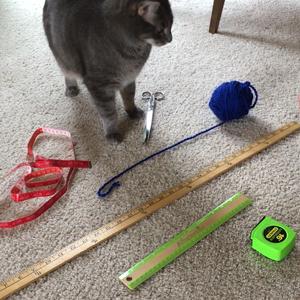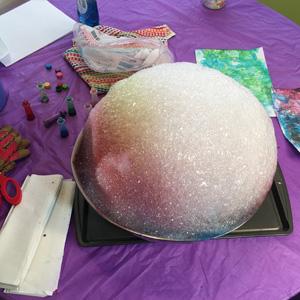Categories
Supplies:
- Ruler (12" or 18" or 36") or measuring tape
- Yarn or string
- Scissor
- A stuffed animal or your pet
Directions:
- Measure, as best you can, your pet or stuffed animal and determine its length in inches.
- After you know how many inches, cut a piece of string or yarn the same length.
- Take this piece of string and measure items around your house. How many cats (or hamsters or dogs, etc.) long is your kitchen? Your table? Your bed?
Please leave a comment below, tell us what you used to measure items around your house.
You can watch this project at: https://www.youtube.com/watch?v=jCU1Ks8mBf0
Supplies:
- One small block of dry ice (about 1 lb.) broken into large pieces. (Do not touch dry ice with bare skin, it will burn!)
- Large bowl on a tray
- Table covering
- Warm water
- Dish soap
- Food Coloring
- Paper (any kind)
Directions:
- Pour warm water into the bowl.
- Add 2-3 squirts of dish soap (it may help to stir the solution gently at this point although I didn't).
- Add a chunk of dry ice using tongs or garden gloves.
- As bubbles rise up, add food coloring (2-4 colors).
- Lay paper over the colorful bubbles and press gently into bubbles. Add a different color and repeat with another piece of paper.
- Keep adding warm water and chunks of dry ice. Or start over with a fresh batch.
- Enjoy your wonderful bubble art!
Watch this project at: https://www.youtube.com/watch?v=852TC3_bSbU&list=PLMEg2Dd0dSFctLfDQxsL5…
Knowledge is power. Unlock your potential!
The PowerPass is a just-for-students library card from PPLD, granting access to the Library’s digital resources like databases, eBooks, and song and movie downloads. Each PowerPass holder can also check out five physical items at a time from any of the 15 PPLD locations or Mobile Library Services.
PowerPass allows you
to access the power of:
- Live Online Tutoring
- Homework Help Guides
- Practice Tests & Prep Courses
- College & Career Planning
- Free Games, Music, & More
With PowerPass, you can also access fun activities such as games, movies, comics, and more!
Visit our eLibrary page for parental control information.



 Ruth Holley Library will be temporarily closed for approximately one week starting Mon., Dec. 2 to complete roof repairs.
Ruth Holley Library will be temporarily closed for approximately one week starting Mon., Dec. 2 to complete roof repairs.
